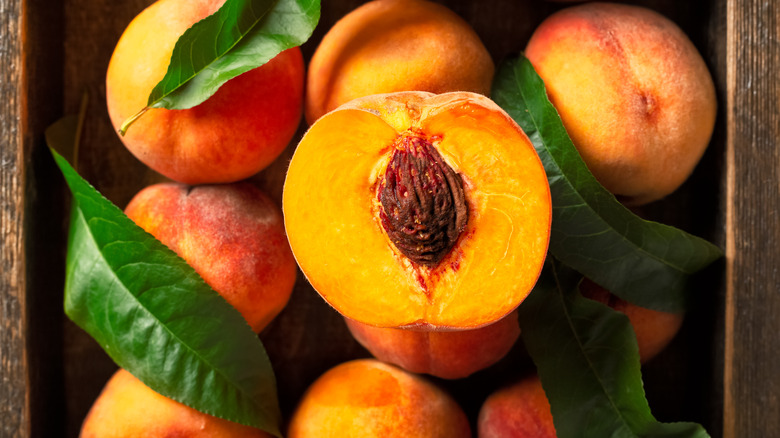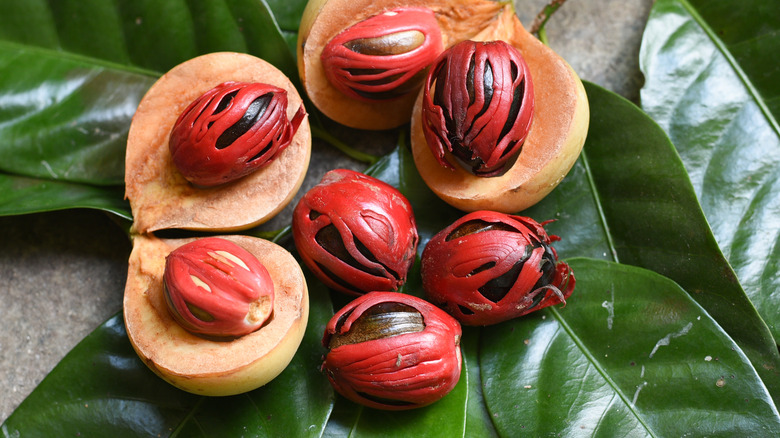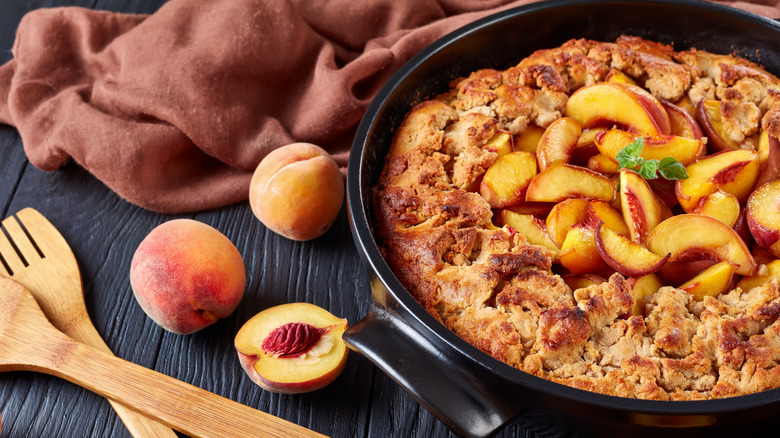The Under-Appreciated Spice That Makes Peach Flavors Shine
We may receive a commission on purchases made from links.
If you hear the word "mace" and think, "Ow, my eyes," let's just say you're utilizing cooking spices all wrong. Introducing: mace, the warming, aromatic spice you never knew you needed — especially if you're gearing up for peach season. (In the U.S., that's May to August.) Let us acquaint you with the other mace, the lesser-known sister spice in nutmeg, which, technically, isn't a spice at all. Nutmeg is actually a fruit with a hard stone at its center, just like — you guessed it — a peach. Inside the hard seed is where we get what we usually refer to as nutmeg, but the seed is surrounded by a red-hued web of lacy fibers known as mace. These fibers are dried and often ground to become nutmeg's hotter, cooler older brother who only listens to bands you've never heard of before. (Seriously though, they are on the piquant side).
Though nutmeg and mace have unique chemical compositions, The Spice House describes the flavor of mace as being somewhere between nutmeg and an orange peel — slightly sweet hint of coriander, citrus, and pine. Its complex, aromatic profile makes for a spiced complement to naturally sweet, bright peaches. Where nutmeg, the typical complement to rich ingredients like sugar and cream, has the potential to weigh down your delicate, in-season peaches, mace is here to elevate it into sensory stardom.
Mace is the place
Mace comes in two forms: pre-ground powder and whole dried "blades." For best results, opt for the intact red mace blades. These will break up easily in a spice grinder or by using a mortar and pestle, and a fresh grind ensures a more potent and pleasant flavor. (For comparison, think fresh vanilla beans versus imitation vanilla extract.) You might even lightly roast them before use to bring out their naturally warm, spiced flavor. (Not to mention, it'll fill the entire kitchen with an intoxicating earthy aroma)
Admittedly pricier than more commonly sourced ingredients like cinnamon, allspice, and ginger, a 0.9-ounce jar of ground mace by McCormick will set you back $2.98 at Walmart. Even steeper, a 1.76-ounce bag of dried whole mace blades by Spice Train runs for $11.99 on Amazon. But this isn't a spice you'll be reaching for every day, and a little goes a long way to up your peach game. Hit up your local grocery store and see what they carry — or this is also a great excuse to visit your local herbal shop.
Peachy pairings for every palate
There's a good chance you've already been cooking with mace without realizing it. It's a common ingredient in many curry and garam masala spice blends and can also be found in milder dishes like English pork pie and Swedish meatballs. Our point is that this little spice packs a big flavor but can make a grand entrance without overpowering the scene.
Mace peach pie and mace peach cobbler are only the beginning. Jar some spiced peach preserves infused with pulverized mace blades. Blend some mace into a batch of homemade peach ice cream. To make the most out of outdoor cooking this summer, sprinkle some ground mace over halved fresh peaches and toss 'em on the grill. Enjoy them as-is, or slice up those grilled mace peaches over a bowl of rice pudding for an elevated dessert. For savory fans, slice those grilled mace peaches into a salad with baby arugula, goat cheese, and roasted beets.
Use a whole mace blade as a garnish for your next peach bellini to impart that woody flavor to your delicate cocktails. It'll add spiced flavor and a vibrant pop of red to boot. You could even use mace in mote con huesillos, a Chilean drink made from peaches and husked wheat. It's refreshing, delicious, and incidentally makes a great mocktail for fans of N.A. spirits.


